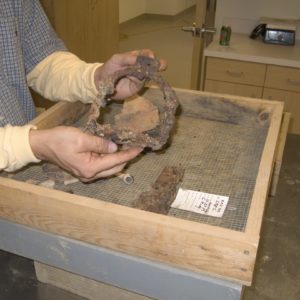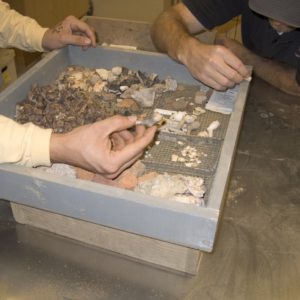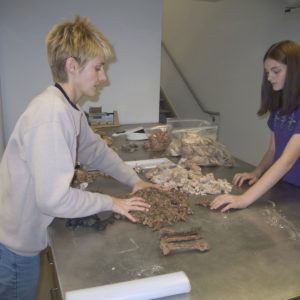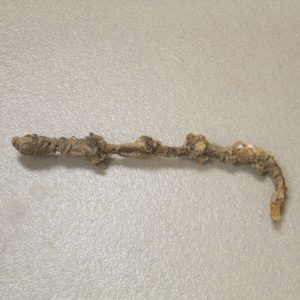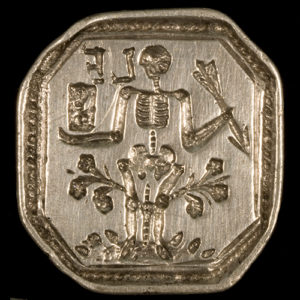Excavations continue near the northern corner of James Fort as the archaeologists’ efforts are focused on a sunken hearth and the well beneath it. The dig has also uncovered the northern bulwark, one of the raised platforms at each of the fort’s corners used as artillery emplacements.
Colonists tried several times to prevent the sinking of a hearth into the filled well beneath it. The hearth is part of a brick addition to a substantial rowhouse building. This rowhouse had a cobblestone foundation and had several chimneys evidenced by a number of “H”-shaped hearths. This particular sinking hearth was built on top of a well that was no longer in use and had been filled in for quite some time. The colonists built a buttress on the side of the hearth to prevent its chimney from tilting further as everything sank. Unfortunately, the buttress was also built on top of the settling well fill so it probably did little to slow the process. This lends itself to the suggestion that the filled-in well had been forgotten by the time the addition to the rowhouse was built. The settlers had tried to repair the hearth several times as evidenced by distinct construction techniques and mortar types.
This well may be the first one built at Jamestown, ordered to be constructed by John Smith in 1609. Evidence suggests that the building built above it was the first governor’s house. Built in 1611 by Lieutenant Governor Sir Thomas Gates, additions were built onto the house by subsequent governors starting in 1617.
The north bulwark of James Fort has been found. The bulwarks at James Fort were circular in nature and had raised platforms serving as artillery emplacements. Now both the north and east bulwarks have been found and the discovery gives the archaeologists a more complete picture of the fort’s size and shape. The western bulwark has been lost to the James River through shore erosion.
The excavation of the hearth and the area nearby has uncovered many interesting artifacts. A dagger with a bent blade and a twisted copper wire hilt was discovered in a fill layer near the hearth. The dagger blade is the same type as two other daggers found previously in the fort. Also found nearby were a cannonball, a masonry trowel, a snaphaunce musket lockplate, a horseshoe, a stirrup, and a crank to a fireplace spit. Several pipe bowls found here can be dated to the first quarter of the 17th century by the shape and size of their bowls. The handle of an English Border ware colander has been found as well as a number of glass trade beads and a decorative ferrule made out of bone.
Perhaps the most interesting artifact found in the area so far is a silver seal featuring a skeleton holding an arrow in one hand and an hourglass in the other. This is typical 16th and 17th-century imagery representing the passing of time and the shortness of life. The owner’s initials, “LF,” are engraved near the skull. These seals were used to imprint designs into hot wax, sealing and authenticating documents, and this is one of many found at Historic Jamestowne.
Archaeologists are continuing their excavations of the hearth and the surrounding area. Once the hearth has been fully excavated, the dig will go further into the depths of the well itself. What is found inside should help tell us if we have in fact found Jamestown’s earliest well.
related images
- The western palisade meets the northern bulwark, which branches to the left
- Stirrup found in hearth well area
- One of several pipe bowls found in the well
- Laboratory assistants begin sorting the finds from the recent excavations
- Handle from an English borderware colander, a decorative bone ferrule, and some black trade beads
- Dagger with bent blade before conservation
- Conserved early padlock found in the Confederate fort area
- Silver skeleton seal




